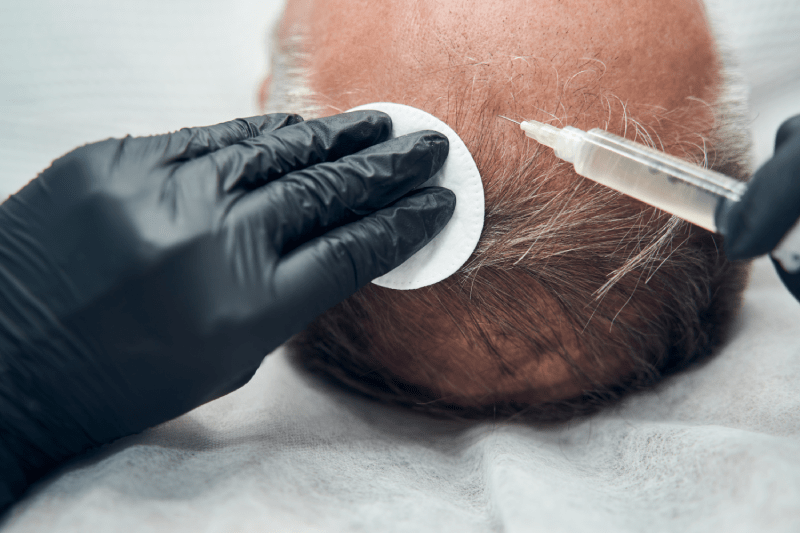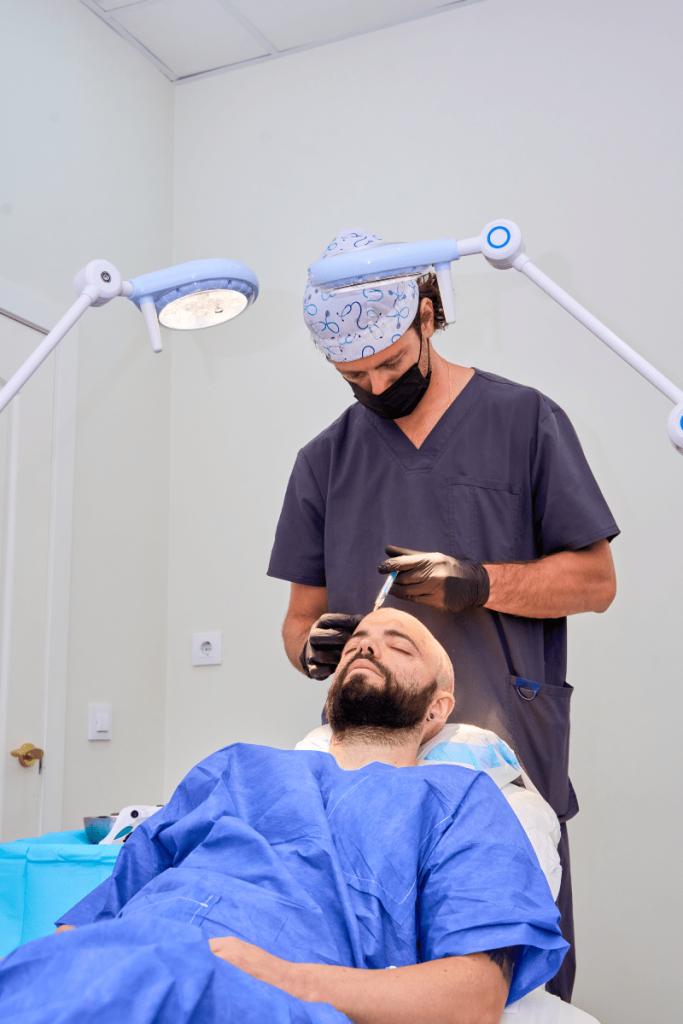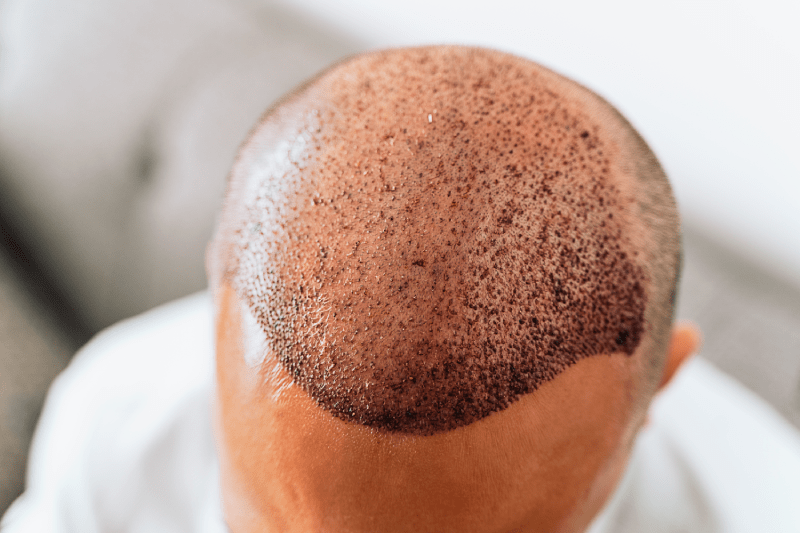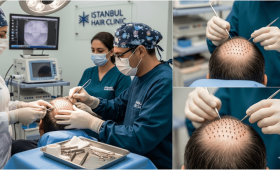How Do FUE And FUT Techniques Differ In Donor Area Procedure?
In the FUE (Follicular Unit Extraction) technique, hair follicles are harvested one by one using special micro motor punches or manual punches. This procedure does not leave a linear scar in the donor area, only small, punctate scars remain. In the FUT (Follicular Unit Transplantation) technique, a strip of scalp is surgically cut and removed from the donor area. This strip is then dissected into follicular units under a microscope. Due to this major difference, FUE is a much more popular option today, thanks to its non-scarring advantage.
Why Does The FUT Technique Leave A Permanent Linear Scar In The Donor Area?
The biggest disadvantage of the FUT technique is that it leaves a long and permanent linear scar in the area where the hair follicles are harvested. This scar occurs because a strip of the scalp is removed and the area is closed with sutures. This linear scar becomes easily noticeable if the patient cuts their hair short. In the FUE technique, the small scars left by the single-unit extractions completely fade when the hair grows. This aesthetic concern is the main reason why FUT has lost its popularity today.
Does The FUE Technique Require Shaving After Hair Transplantation?
The FUE technique generally requires complete shaving of both the donor and recipient areas. Shaving the donor area is essential for harvesting the follicles without damage and at the correct angle. Shaving the recipient area increases the precision of the channel opening and reduces the risk of infection. However, unshaven FUE techniques have also been developed in recent years; these methods are suitable for smaller areas and do not require shaving the entire recipient area, which allows the patient to return to social life faster.
Which Technique Is Considered More Efficient For Large Transplant Areas?
The FUT technique was historically considered more efficient for very large transplant areas because it allowed for a high number of grafts (4,000-5,000 grafts) to be obtained quickly from a single strip excision. However, today, thanks to the use of micro motors in the FUE technique and the possibility of extending the operation time, FUE can also successfully perform transplants of 5,000 grafts and more. FUE offers the advantage of leaving no scar and using the donor area more homogeneously, making it the primary choice in modern medicine.
How Does The Recovery Period Differ Between FUE And FUT?
Because the FUT technique involves a major surgical incision and sutures, the recovery period is longer and more painful. The sutures are usually removed after 10-14 days, and recovery can take weeks due to the feeling of tension in the donor area. In the FUE technique, only micro-holes are created, making the recovery much faster and more comfortable. The donor area usually heals completely within 7-10 days, and the patient can return to daily life much sooner. This faster recovery is a major reason for preferring FUE.

Why Is The FUT Technique No Longer Preferred Today?
The FUT technique has been largely abandoned today due to it leaving a permanent and visible linear scar in the donor area, having a long and painful recovery process, and involving a large surgical incision during the operation. Patients prefer scar-free micro-surgical methods like FUE or DHI because they do not want to lose the freedom to cut their hair short. FUT is an older method that can only be considered in rare and extreme cases where the donor area is very limited.
Which Technique Has A Higher Graft Survival Rate?
The fundamental factor determining the graft survival rate (the success of grafts taking hold) is not the technique itself, but the time the follicles spend outside the body and the clinic’s experience. Although the strip of tissue removed in FUT is immediately placed in a cold solution, the dissection of the follicles can take a long time. In FUE, the follicles are harvested individually and quickly and then kept in a solution. FUE, when combined with modern methods that minimize the time follicles spend outside (DHI, Sapphire FUE), offers high survival rates.
What Is The Price Difference Between FUE And FUT?
The FUT technique generally tends to be lower priced than FUE. This is because FUT is an older method that requires less technological equipment and has lower operational labour costs (excluding follicle separation). However, FUE offers the advantages of no scarring and better aesthetics. Thanks to the low operational costs in Turkey, FUE techniques can be offered at prices much more affordable than even the FUT prices in the West. This situation makes the price difference negligible for patients choosing quality.
Is The Aesthetic Result Achieved With The FUE Technique More Natural?
Yes, the aesthetic result achieved with the FUE technique is considered much more natural than with FUT. In FUE, hair follicles are harvested individually and can be placed into the opened micro-channels at more precise angles. This ensures the hairline has a softer, more natural transition. In FUT, the tension in the donor area due to the large incision can affect the angle of hair growth, leading to a synthetic appearance. Therefore, FUE is an indispensable method for aesthetic success.
Which Method Makes Unshaven Hair Transplantation Possible?
The option of unshaven hair transplantation is possible with a special application of the FUE or DHI techniques; unshaven transplantation cannot be done with the FUT technique. Unshaven FUE aims to facilitate the camouflage of the transplanted area by leaving the existing hair long. While FUE may require partial shaving for large areas, the DHI technique is more suitable for completely unshaven transplantation. This is an important detail for women and those who want to quickly return to social life, and it is an advantage of FUE/DHI.
Which Technique Is Less Restrictive In Case Of A Second Hair Transplant Need?
The FUE technique is much less restrictive in the event of a second or third transplant (revision) because it uses the donor area homogeneously and leaves no permanent linear scar. The scar left after FUT limits the use of a portion of the donor area and increases the risk of a second strip excision. FUE preserves the donor area, providing better opportunities to manage the transplant reserve against possible future hair loss.
How Are Follicles Harvested And Prepared In The FUT Technique
In the FUT technique, first, a strip of scalp is removed from the donor area (usually the back of the head) with a surgical incision. This strip of skin is then separated into individual follicular units (grafts) by a team working under a microscope or with magnification tools. This separation process requires great care to avoid damaging the follicles and is quite time-consuming. After the grafts are separated, they are placed into the channels opened in the recipient area.

Which Technique Has A Higher Level Of Post-Operative Pain?
Because the FUT technique involves a large surgical incision and sutures, the post-operative pain level is significantly higher than FUE and may last longer. The pain usually stems from tension and nerve irritation in the donor area. The pain experienced in FUE is micro-level and can usually be easily controlled with prescribed painkillers for only the first 2-3 days. FUE offers much greater comfort for the patient.
Why Do Clinics In Turkey Prefer FUE And DHI More?
Modern clinics in Turkey prefer FUE and DHI techniques instead of FUT to comply with international standards and meet patients’ aesthetic expectations. Since patients’ biggest expectation is no scarring and a natural appearance, the permanent linear scar left by FUT is no longer acceptable. FUE and DHI are the priority methods for specialists in Turkey because they are minimally invasive, offer fast recovery, and provide high aesthetic results.
How Does The FUE Technique Manage The Time Follicles Spend Outside The Body?
In the FUE technique, hair follicles are harvested individually and are kept in special cold and nourishing solutions (e.g., HypoThermosol) until the channels are opened in the recipient area. These solutions are critically important for preserving the viability of the follicles. Experienced teams work quickly to minimize the time follicles spend outside the body, which should generally not exceed 4 hours. Proper storage of the follicles in these solutions is the foundation of FUE’s success.
Which Technique Allows Hair To Be Used Shorter?
The FUE technique allows the hair to be used very short (e.g., grade 1) because it leaves only punctate scars in the donor area. In the FUT technique, the patient must keep their hair at least 6-10 mm long to camouflage the remaining linear scar. FUE offers essential aesthetic freedom for patients who like to cut their hair short or do not want to carry a visible scar in the back of their head.
When Are Sutures Removed And How Are Scars Concealed In The FUT Technique?
The sutures in the strip area removed in the FUT technique are usually removed after 10 to 14 days. Even after the sutures are removed, a permanent and visible linear scar remains in this area. Patients must grow their hair long to conceal this scar. Although the scar may fade and thin over time, it never completely disappears. In some cases, this scar can be camouflaged by implanting FUE-harvested grafts directly onto the scar (scar revision).
Why Is The FUT Technique Priced Lower Than FUE?
The FUT technique is priced lower than FUE because it requires less technological investment (scalpel and sutures instead of micro motor and precision punches) and reduces the operational burden of channel opening. However, the superiority of FUE in terms of aesthetic results and recovery comfort has made patients accept the price difference. The affordable prices of FUE in Turkey have almost entirely phased out FUT.
Which Technique Can Adjust The Angle Of Hair Growth More Naturally?
The FUE technique, especially when combined with modern versions like Sapphire FUE and DHI applications, can adjust the angle and direction of hair growth with millimetric precision. This ensures a more natural lie and direction in the hairline. In FUT, due to the tension and angle of the incision, the angles may not be adjusted as precisely as in FUE. The correct angle and direction are key to the transplant looking realistic, not synthetic.
Which Technique Sees Less Scabbing During The Recovery Process?
The FUE technique sees less scabbing than FUT because the channel opening procedure is micro-level. In FUT, the large wound and suture area cause more scabbing and fluid accumulation during the recovery process. The scabs formed in FUE usually shed within 7-10 days with gentle washing, while healing in the FUT area is longer and more tedious.
Can The Linear Scar Left After FUT Be Covered With FUE?
Yes, the linear scar left in the donor area after the FUT technique can be successfully camouflaged using the FUE technique. This procedure is called scar revision. Hair follicles harvested individually from other healthy parts of the donor area using FUE are carefully implanted onto the linear scar. As the follicles grow, they cover the scar, allowing the patient to cut their hair shorter. This demonstrates how important FUE is as an aesthetic correction tool.
Which Technique Has Less Post-Operative Trauma And Swelling?
The FUE technique involves only micro-surgical incisions the size of a needle tip, causing much less trauma and swelling (edema) in the body compared to FUT. Due to the removal of large tissue in FUT, edema and bruising can be more intense. In FUE, swelling usually subsides within 5-7 days, and patients can continue their daily lives with almost no interruption. The minimal trauma of FUE enhances patient recovery comfort.
Which Method Is Better For Patients With Limited Hair Follicle Count?
For patients with a very limited hair follicle count and a weak donor area, both methods carry risks. However, the FUE technique provides more efficient use because it harvests the follicles more homogeneously and individually. FUT consumes a large area in a strip, reducing the chances of a second transplant. FUE offers a more flexible solution for limited donor areas by allowing the use of beard or body hair (BHT) as a donor source if needed.

Why Does The FUE Technique Carry A Lower Risk Of Infection During Recovery?
In the FUE technique, the incisions in the areas where the follicles are harvested and implanted are micro-level, so the risk of infection is lower than in FUT. The long surgical incision and suture area in FUT create a larger surface area for bacteria to proliferate. In FUE, the risk arises only when the clinic’s sterilization standards are not meticulously adhered to. Modern and accredited clinics apply FUE under sterile conditions, reducing this risk to zero.
Why Might Follicles Harvested In The FUT Technique Survive Longer?
The strip of scalp removed in the FUT technique provides the follicles with a higher chance of remaining with the surrounding supportive tissues when harvested as a whole. This theoretically makes the follicles more protected against external factors. However, this advantage can be lost during the dissection of the follicles under the microscope. Today, thanks to cold solutions and fast implantation in FUE, the survival rate of FUE is as high as that of FUT.
Which Technique Sees Post-Operative Numbness Last Longer?
In the FUT technique, the nerves in the donor area may be cut or traumatized due to the large surgical incision, which can lead to long-term numbness (loss of sensation) after the operation. This numbness can rarely last for months. In the FUE technique, since only micro-holes are opened, the feeling of numbness is much shorter and usually disappears completely within a few weeks. The risk of long-term numbness is another significant disadvantage of FUT.
Can Higher Graft Density Be Achieved With The FUE Technique?
The FUE technique, especially when combined with sensitive tips like Sapphire FUE, allows for higher graft density in the recipient area compared to FUT. The micro-channels opened in FUE can be placed more closely and controlled between existing hairs. This facilitates achieving a denser and more aesthetically pleasing appearance in the crown and front hairline areas. In contrast, channel opening in FUT is performed with a more conventional method, and density may not be adjusted as precisely as in FUE.
What Is The Risk Of Infection From An Unhealed Wound In The FUT Technique?
The failure of the sutured area in the FUT technique to heal or reopening carries a serious risk of infection and requires immediate medical intervention. The large incision area creates a suitable ground for the infection to spread. This situation can lead not only to the failure of the transplant but also to complications that threaten the patient’s general health. In FUE, this risk is almost non-existent because the micro-incisions close naturally.
Which Technique Is Used As The Primary Method For Revision Surgeries?
The FUE technique is used as the primary method for revision surgeries. There are two main reasons for this: First, FUE has the ability to implant hair onto scars to camouflage the linear scars left by FUT. Second, FUE can continue to harvest homogeneously from the donor area to correct existing transplant errors or densify sparse areas. The FUT technique is very restrictive for revision and usually carries the risk of a new incision.
Why Is The FUE Technique Better For Patients With Progressive Hair Loss?
The FUE technique is better for younger patients with the potential for progressive hair loss because it uses the donor area homogeneously and efficiently. This preserves sufficient graft reserve for a second or third transplant if shedding continues in the future. FUT leaves permanent damage in the donor area due to the strip excision, severely reducing the chance of future transplants. FUE offers a long-term solution strategy with this flexibility.
Which Technique Carries The Risk Of Donor Area Thinning Over A Wide Area
In the FUT technique, cutting a strip causes a dense area of the donor region to be permanently removed. In the FUE technique, if follicles are harvested non-homogeneously and concentrated in specific areas by inexperienced hands, there is a risk of thinning over a wide area (over-harvesting) in these regions. This thinning may be noticeable when the hair is cut short. Experienced FUE specialists spread the harvesting evenly across a wide surface to minimize this risk.
Why Might Follicles Harvested In The FUT Technique Be Shaped Faster?
The strip of scalp removed in the FUT technique provides the laboratory team with intact tissue, allowing the grafts to be separated under the microscope more quickly and controlled. This allows the transplant team to shape the follicles faster. In FUE, the process is longer because each follicle is separated and counted individually. However, the fact that FUE follicles have less contact with external factors can compensate for this speed difference.

How Is The Aesthetic Difference Between FUE And FUT Techniques Understood In Turkey?
To understand the aesthetic difference between FUE and FUT techniques in Turkey, the most important indicator is the donor area. Patients who have undergone FUE show no linear scar even if the back of their head is cut short. Patients who have undergone FUT retain a visible linear scar. In the recipient area, FUE offers a more natural hairline and softer angles. This aesthetic difference is the main reason why patients prefer FUE.
Which Technique Affects Blood Circulation Less ?
The FUE technique affects the blood circulation and vascular structure of the scalp much less than FUT because it only opens micro-holes. The long surgical incision made in the FUT technique cuts blood vessels and nerves in that area, which slows down the recovery process and negatively affects circulation. The minimally invasive nature of FUE supports the faster nourishment of the follicles after implantation.
How Many Grafts Are Needed To Cover The Scar Left After FUT?
The number of grafts needed to cover the linear scar left after FUT depends on the size, width, and the contrast between the patient’s hair colour and skin. Generally, a density of 25 to 40 grafts per square inch may be sufficient to camouflage this scar. This procedure is usually performed with a second FUE session, and specialists must plan this revision carefully
Which Technique Is More Suitable For Elderly Patients?
The FUE technique is generally more suitable for elderly patients due to the ease of implantation and fast recovery comfort. FUT requires a major surgical incision and sutures, which can make wound healing difficult for elderly patients. FUE is a safer option that provides maximum comfort with minimal trauma for elderly patients whose general health condition is good.
Which Technique Guarantees The Most Accurate Hair Angle?
The FUE technique, used with DHI (Choi Pen) or Sapphire Blades, ensures that the angle and direction of the channel where the graft will be implanted are determined with millimetric precision beforehand. This precision perfectly aligns with the natural growth angles (15 to 45 degrees) of the hair, guaranteeing the most natural result. This technical precision is an advantage that manual incision-requiring FUT cannot provide.
CONCLUSION: Hair transplantation has largely shifted in favor of the FUE technique because FUE offers three fundamental advantages: no scarring, fast recovery, and high aesthetic naturalness. The FUT technique has been almost entirely abandoned today due to the permanent linear scar and long recovery period.
To achieve successful and natural results in hair transplantation, the experience, artistic skill of the specialist, and the clinic’s hygiene standards are more important than the technique itself.
If you want to have a hair transplant with the latest techniques (Sapphire FUE, DHI) and the highest aesthetic standards, we strongly recommend you contact Cure Holiday, which offers personalized, transparent packages and works with internationally accredited centers.



